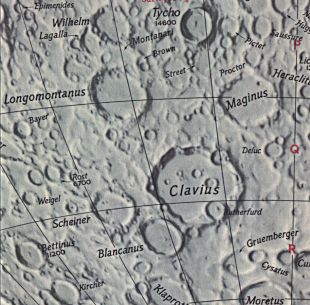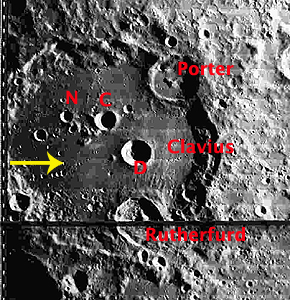

Observer: Tony Donnangelo
Date/time of observation: 2004/08/09 06:30 U.T.
Site location: Weiser State Forest, PA, USA
Site coordinates: N. 40°30’51.7” (40.51437°) W. 76°46’40.5” (76.77791°)
Site elevation: 524 meters (1,720feet)
Site classification: State forest wilderness area
Instrument: 14.5” Starmaster Dob.
Magnification: 203x, 267x, 351x
Moon's age: 22d 19:05, illuminated 37.1%
Librations: 4.9°, PA 231, N/S -3.08°, E/W 3.78°
Object: Clavius (walled plain)
Crater size: 225x225Km (140x140Mi)
Height/Wide ratio: 0.0204
Lunar ray coordinates: 18.5°W, 59.0°S.
Rukl chart #: 72
It was a poor night for observing. That isn’t anything new in Pennsylvania this year. There were many clouds as astronomical twilight ended. There were periods of total cloud cover. There was little wind and only slight dew. I had the opportunity to take many breaks and napped for a few hours.
I arrived at the site before sunset and set up my equipment. When seeing completely deteriorated by 03:30 U.T., I took a nap and awoke at 06:00 U.T. The sky partially cleared enough to start observing again. By 06:30 U.T., the moon rose sufficiently above the trees and was clear of the clouds. I looked for signs of a ray predicted to occur a few hours later at 10:03 U.T. in the crater Pitatus. The crater was still illuminated. The ray did develop later that morning. Rimae were obvious on the floor of the crater. The floor of crater Wurzebauer, southwest of Pitatus, appeared very unusual. Most of the floor looked like a raised sponge-like dome. Don’t pass up observing Rima Hesiodus.
Clavius immediately attracted my attention. The eastern half of the crater was within the terminator. The summit of the eastern wall, between Porter and Rutherfurd, had shown extremely brilliant white. The northeastern wall areas of craters C and D, within Calvius, were also a very bright white, but not as striking as the rim. The solar angle revealed the wall heights of these two craters. I was very pleasantly surprised. The floor was completely shadowed, except for a rather wide cone–shaped beam of light extending approximately 102 Km. (63 miles) from the western wall to the southwestern rim of D. This is certainly worth your time to enjoy.
Keeping in mind that sunset lunar rays generally behave opposite of sunrise rays, I occasionally monitored the beam of light within the crater. Sunrise rays usually get larger as the sun rises, whereas sunset rays usually get narrower and/or shorter as the sun sets. I wasn’t disappointed.
The Initial Predictions, Using Data in Original Reporting
Site Longitude = +76.778
Site Latitude = +40.513
Site Elevation = +524.000
Reproducing Lighting For: 2004/8/9 at 06:30 U.T.
Desired Solar Altitude = +0.582(Setting), Azimuth = +273.846
Feature = CLAVIUS
Feature Longitude: = -14.400
Feature Latitude: = -58.400
Average Co-longitude = 193.289
Moon's Altitude Restricted = N
In the Time column, D=Daylight, T=Twilight
---- Moon's ---- -- Earth's --
Topocentric Topocentric -------- Sun's --------
UT Date Time Alt° Semi-Diam'' Long° Lat° Colong° Lat° Azim°
2004/08/09 18:38D +11.589 886.44 +2.486 -3.053 196.995 +1.515 +268.583
Crater Description:
Description from Virtual Moon Atlas: Damaged circular formation. Steep slopes riddled supporting crater Blancanus to the southwest. Very high walls ridden by the craters Porter to the northeast, Rutherfurd to the southeast, Clavius K to the southwest, and Clavius L to the west. Large flat floor with Clavius D C N J & JA on an arc of circle. Numerous craterlets whose a chain to the southwest. Lines of crests.

